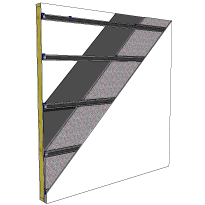Soundproofing Existing Walls And Ceilings

Then use a roller to press the cellulose flat before it dries.
Soundproofing existing walls and ceilings. Lastly seal the wall with sheetrock using sealant to cover up and secure the edges. They can have a commercial industrial look but may suit modern home décor. How to soundproof an existing ceiling. Some tiles attach to the existing ceiling to wood furring strips or steel t grid.
The principle of soundproofing is simple. However if you prefer to keep your walls and ceilings in place and are content with a solid upgrade about 6 9 stc points then we have outlined the proper. Knowing that you should make an effort to learn about the best soundproof insulation you could use in walls and ceilings. The soundproof curtains are hung on standard curtain rods which can be mounted to the ceiling or the walls.
Do it again steps 1 6 until your complete wall or ceiling is protected in mlv. This technique requires quite a bit of. If you want to soundproof your existing interior walls insulation is one of your best friends. Once that s set up spray the area with damp blown cellulose which is a soundproofing material.
Where mlv seams comes between studs overlap items by 2. Whether you have noisy neighbors upstairs at a condo complex or simply loud teenagers in their bedroom a thin ceiling can allow a lot of sound to emanate. For best soundproofing results you should consider removing your existing wall or ceiling and start the sound control process from your studs as detailed in our how to soundproof article. Where mlv seams show up over a stud butt pieces against each other and tape with vinyl fabric or foil tape.
Insulating products are a key component of any soundproofing project. It works by reducing the ability of sound to travel between point a and point b and is realized by reduction and absorption of noise. For soundproofing a ceiling soundproofing experts recommend this insulation see it on home depot and this damping compound see it on amazon. First we have to make the distinction between insulating products and other soundproofing materials there are many materials you can attach to your wall to approximate the way insulating products work.
To soundproof a wall or ceiling during construction start by installing a basic frame. Build on top of the existing wall. Nail a board to the ceiling and another one to the floor. Installing acoustic ceiling tiles is another option for soundproofing a ceiling.
Add some evenly spaced vertical boards. Some tiles are available in different colors and surface profiles. You ll need wood to make the stud frame on top of the wall.














































